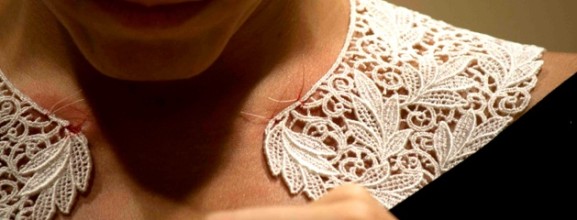Silvia Giambrone was born in Agrigento in 1981. She has been living and working in Rome since 2002, when she got into Rome Fine Arts Academy.
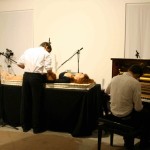 The personal element is fundamental to her work: this, together with universally recognized themes, is one of the various research fields of her artistic production. One of the most important among these is certainly the case of body, which is at the same time fertile research field and active tool to develop different projects: in “La viola e un poco nervosamente” (2010), the body of the artist abandons its social identity representation to play the role of a musical instrument: Silvia disappears, the artist disappears and gets replaced by an object which has a specific function, that is playing music. In this performance the heartbeat rhythm becomes the arrangement for an improvised melody underlining how our society gets actually influenced by the context where things appear and by labels they get. Silvia Giambrone shows us that a half-naked body is not necessarily an object of desire, something which is instead always maintained by today’s media bombing of images.
The personal element is fundamental to her work: this, together with universally recognized themes, is one of the various research fields of her artistic production. One of the most important among these is certainly the case of body, which is at the same time fertile research field and active tool to develop different projects: in “La viola e un poco nervosamente” (2010), the body of the artist abandons its social identity representation to play the role of a musical instrument: Silvia disappears, the artist disappears and gets replaced by an object which has a specific function, that is playing music. In this performance the heartbeat rhythm becomes the arrangement for an improvised melody underlining how our society gets actually influenced by the context where things appear and by labels they get. Silvia Giambrone shows us that a half-naked body is not necessarily an object of desire, something which is instead always maintained by today’s media bombing of images.
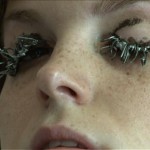 Following this, the performance “Eredità” (2008) is based on the analysis of seduction techniques and especially on the everyday habit of make-up: the artist attaches fake metal eyelashes on her eyes, symbols of the cosmetic habits to which women are forced from time immemorial because of the cultural legacy imposing on them to be pleasant to men’s eyes.
Following this, the performance “Eredità” (2008) is based on the analysis of seduction techniques and especially on the everyday habit of make-up: the artist attaches fake metal eyelashes on her eyes, symbols of the cosmetic habits to which women are forced from time immemorial because of the cultural legacy imposing on them to be pleasant to men’s eyes.
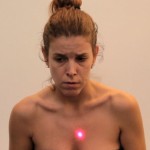 Silvia Giambrone’s body is then the target of a laser which is drawn on her naked skin in “Sotto tiro” (2013): the artist is subject of an unknown and unmotivated threat, that is the actual being within reach of a laser which turns her into a convicted victim. Such intrusive light signal might also represent the harassing gaze which is impossible to escape from and which violates personal intimacy causing discomfort.
Silvia Giambrone’s body is then the target of a laser which is drawn on her naked skin in “Sotto tiro” (2013): the artist is subject of an unknown and unmotivated threat, that is the actual being within reach of a laser which turns her into a convicted victim. Such intrusive light signal might also represent the harassing gaze which is impossible to escape from and which violates personal intimacy causing discomfort.
 “Teatro anatomico” (2012) is a performance presented on the occasion of the collective exhibition “Re-generation”: an embroidered collar is sewed on the artist’s neck. The brutality of the needle piercing her flesh contrasts with the simplicity of the artist’s reaction: she shows off her collar as an accessory which at the end of the performance has made her more beautiful, pleasant and feminine. This performance conveys a strongly symbolic message: the collar represents both religious and political authority (priests’ white collars, but even more the collars of those well-pressed shirts underneath powerful men’s coats), as well as rigor, recalling girls’ school uniforms and smocks. The fact that the collar is being sewed by hand inevitably refers back to feminist artistic production and culture, as well as to Italian women’s past condition which regarded to sewing as one of the few activities allowed.
“Teatro anatomico” (2012) is a performance presented on the occasion of the collective exhibition “Re-generation”: an embroidered collar is sewed on the artist’s neck. The brutality of the needle piercing her flesh contrasts with the simplicity of the artist’s reaction: she shows off her collar as an accessory which at the end of the performance has made her more beautiful, pleasant and feminine. This performance conveys a strongly symbolic message: the collar represents both religious and political authority (priests’ white collars, but even more the collars of those well-pressed shirts underneath powerful men’s coats), as well as rigor, recalling girls’ school uniforms and smocks. The fact that the collar is being sewed by hand inevitably refers back to feminist artistic production and culture, as well as to Italian women’s past condition which regarded to sewing as one of the few activities allowed.
 Silvia Giambrone appropriates this technique and one of the first works where she employs it is “Il Pizzo” (2012): tiny fragments of blue lace cover the faces of female figures in her parents’ wedding pictures. Lace turns into a mask which hides these women’s identity: on the one hand, times has now changed them so much that they cannot even recognize themselves in those pictures anymore, on the other hand, this also implies the paradoxical possibility of preserving them from fading paper, which will make them completely disappear. Also, the artist leaves only the faces of male attendants in order to better underline how the theme of female beauty is again indelibly tied to the dictates of male culture.
Silvia Giambrone appropriates this technique and one of the first works where she employs it is “Il Pizzo” (2012): tiny fragments of blue lace cover the faces of female figures in her parents’ wedding pictures. Lace turns into a mask which hides these women’s identity: on the one hand, times has now changed them so much that they cannot even recognize themselves in those pictures anymore, on the other hand, this also implies the paradoxical possibility of preserving them from fading paper, which will make them completely disappear. Also, the artist leaves only the faces of male attendants in order to better underline how the theme of female beauty is again indelibly tied to the dictates of male culture.
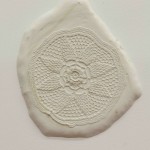 Lace as the proof of an old female tradition tied to Southern Italy and to those female ancestors who spent their time sewing: these are the key concepts of the work “Made in Italy”. Our country is still strongly anchored to its past and this cultural weight, which is both a dead weight and a treasure to pass on posterity, is represented by a plaster block with stamped molds of collars. Giambrone’s “Made in Italy” is a mirror of nowadays society which once again portrays women in a condition dependent on men.
Lace as the proof of an old female tradition tied to Southern Italy and to those female ancestors who spent their time sewing: these are the key concepts of the work “Made in Italy”. Our country is still strongly anchored to its past and this cultural weight, which is both a dead weight and a treasure to pass on posterity, is represented by a plaster block with stamped molds of collars. Giambrone’s “Made in Italy” is a mirror of nowadays society which once again portrays women in a condition dependent on men.
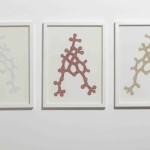 However, sewing is not useful to only create pretty and decorative clothes ornaments: proof of this is “Eroina” (2012), the hooked reproduction of the molecular structure of heroin. There is both a strong contrast between the concept of crochet hook itself and the final result, as well as a subtle meaning game around the title of the work: heroin, indeed, might be associated both with the drug and a powerful female figure come to rescue society.
However, sewing is not useful to only create pretty and decorative clothes ornaments: proof of this is “Eroina” (2012), the hooked reproduction of the molecular structure of heroin. There is both a strong contrast between the concept of crochet hook itself and the final result, as well as a subtle meaning game around the title of the work: heroin, indeed, might be associated both with the drug and a powerful female figure come to rescue society.
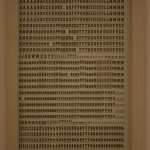 One of her favorite communications media is writing. Language is the tool which allows Silvia Giambrone to create her “Autoritratto – Io nel settembre 2009 all’altezza di un universo senza risposte” (2010), where everything revolves around the concept of subtraction: there is, indeed, physical subtraction when she gets rid of all the letters which make up the title of the work from moving sheets with the letters of the alphabet. Inspiration for this piece comes from Carla Lonzi’s “Sputiamo su Hegel” which deals with the theme of the actual possibility for the subject to exist regardless of the dialectic condition which defines him, that is out of a definite context where he exists unwillingly.
One of her favorite communications media is writing. Language is the tool which allows Silvia Giambrone to create her “Autoritratto – Io nel settembre 2009 all’altezza di un universo senza risposte” (2010), where everything revolves around the concept of subtraction: there is, indeed, physical subtraction when she gets rid of all the letters which make up the title of the work from moving sheets with the letters of the alphabet. Inspiration for this piece comes from Carla Lonzi’s “Sputiamo su Hegel” which deals with the theme of the actual possibility for the subject to exist regardless of the dialectic condition which defines him, that is out of a definite context where he exists unwillingly.
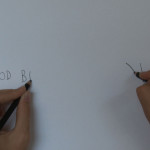 Words meet the body in “Translation” (2009), a performance which investigates the relationship between language and reality: the language we speak is considered just like Law, a code which defines everything; however, someone’s hands simultaneously writing the same sentence in different languages help showing the illusion of the idea that there exists a correspondence between words and real objects. In the same way, the commandment “You shall have no other gods before me” is translated into another language and simultaneously written in two different ways by the same person, showing how the concept present in those words gets actually betrayed.
Words meet the body in “Translation” (2009), a performance which investigates the relationship between language and reality: the language we speak is considered just like Law, a code which defines everything; however, someone’s hands simultaneously writing the same sentence in different languages help showing the illusion of the idea that there exists a correspondence between words and real objects. In the same way, the commandment “You shall have no other gods before me” is translated into another language and simultaneously written in two different ways by the same person, showing how the concept present in those words gets actually betrayed.
Attention to words is found also in “No Enemy” (2008), an installation with big and heavy wooden letters covered with lead which invade the foyer space of the third level of MART in Rovereto. The absence of space between the words “no” and “enemy” initially confuses the beholder who hardly understands the meaning of those words. Once again the artist unmasks the ambiguousness of language and the meanings attached to it.
Silvia Giambrone has been collaborating with various galleries: Il ponte contemporanea, Roma; Galleria Bonomo, Bari; Galleria Deanesi, Rovereto; Galleria Biagiotti, Firenze and starting from 2012 Galleria Doppelgaenger, Bari.
She has recently won the Main Prize at Kaunas Biennial.
Among her personal exhibitions: L’impero libero degli schiavi, Galleria Doppelgaenger, Bari (2012); Parallel Borders, Roma, curated by Mark Mangion (2012); Sotto falso nome, Fondazione Spazio13, Warsaw (2011); Fuori di me, Spazio Ferramenta, Torino, curated by Susanna Sara Mandice (2011); Invito all’opera, Galleria Il ponte contemporanea, curated by Achille Bonito Oliva (2010); More to come, Upload Art Project, curated by Silvia Conta, Federico Mazzonelli, Julia Trolp (2010); Speaking your language I learnt how to hate you, Galleria NextDoor, Roma, curated by L. Benedetti (2008).
Among her main collectives, the most recent ones are: KAUNAS BIENNAL UNITEXT ’13, National Museum of M. K. Čiurlionis (20013); Refuse, Ex Mattatoio di Testaccio, La Pelanda, Roma, curated by Roberto D’Onorio (2013); SUBJECTIVE MAPS/ DISAPPEARENCES, Parallel Borders 1 / Monuments & Shrines to Capitalism curated by Mark Mangion for Malta Contemporary Art, National Gallery of Iceland (2013); MEDITERRANEA 16, Biennial of Young Artists from Europe and the Mediterranean (BJCEM), Ancona (2013); Autoritratti. Iscrizioni del femminile nell’arte italiana contemporanea, MAMbo, curted by Uliana Zanetti, Bologna (2013); Vetrinale, Roma, curated by Cecilia Casorati, Micol di Veroli e Yuri Elena (2012); Re-Generation, MACRO Testaccio, Roma, curated by Maria Alicata e Ilaria Gianni (2012).
Related Posts
« Dan Witz – Public and Confidential @ Wunderkammern Zoom – Benedetta Falugi »

